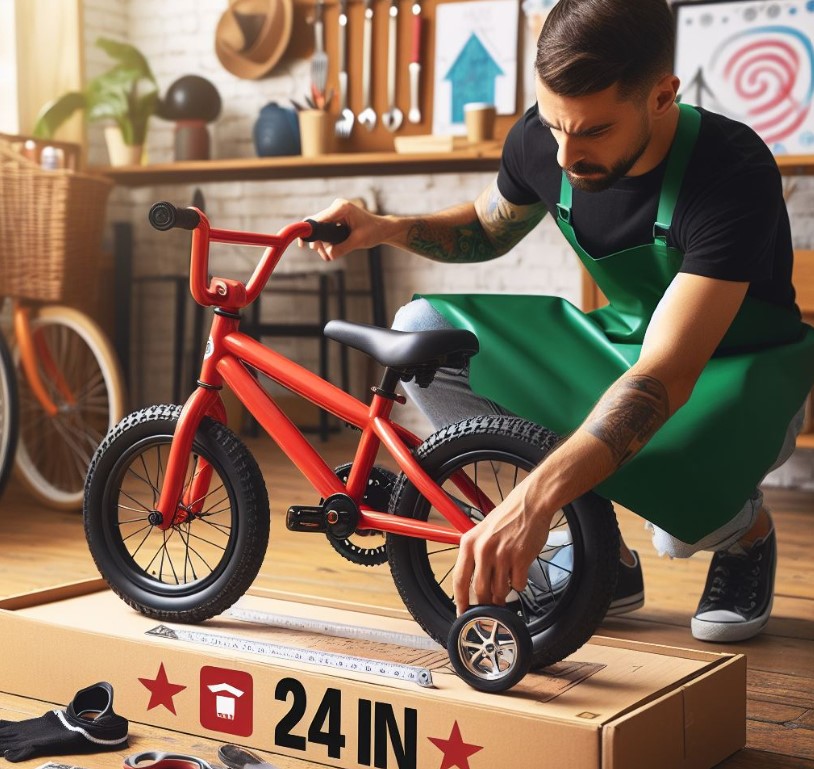Can You Put Training Wheels On A 24 Inch Bike? Answered
Exploring the realms of cycling introduces a pivotal question for young riders and their guardians: Can You Put Training Wheels On A 24 Inch Bike? This inquiry not only highlights concerns about safety and learning but also delves into the adaptability of bicycles to support the journey of growing cyclists. As we navigate through the intricacies of bike sizes, training wheels, and rider readiness, we aim to provide a comprehensive understanding that ensures a seamless transition for budding cyclists.
Key Takeaways
- Yes, you can attach training wheels to a 24-inch bike with the right adjustments.
- The process requires specific types of training wheels designed for larger bikes.
- Safety and comfort are paramount, emphasizing the need for proper installation.
Can You Put Training Wheels On A 24 Inch Bike?
Yes, you can put training wheels on a 24-inch bike. This adaptation requires specific training wheels designed to accommodate the size and weight of larger bikes, ensuring both safety and stability for the rider.

Understanding Training Wheels and Bike Sizes
Compatibility and Considerations
When it comes to adding training wheels to a 24-inch bike, understanding the compatibility between bike sizes and training wheel specifications is crucial.
Bikes designed for children and young adolescents often range from small to large sizes, with 24-inch bikes typically recommended for those between the ages of 8 to 12.
However, not all training wheels are created equal. The market offers specialized training wheels that are designed to accommodate the weight and height of larger bikes, ensuring stability and safety.
Types of Training Wheels for 24-Inch Bikes
Selecting the right type of training wheels for a 24-inch bike involves considering the rider’s weight, the bike’s design, and the desired level of support.
Heavier-duty training wheels are often required for larger bikes to adequately support the increased weight and provide a balanced learning experience.
Manufacturers have responded to this need by creating robust training wheels that attach securely to 24-inch bikes, offering a range of adjustment options to grow with the rider.
Installation Process
Tools and Materials Needed
The installation of training wheels on a 24-inch bike is straightforward with the right tools and materials. A basic toolkit including wrenches, screwdrivers, and possibly a drill (for certain models) is essential.
Additionally, ensuring that the training wheels are compatible with the bike model will streamline the installation process. It’s important to read through the manufacturer’s instructions thoroughly before beginning to ensure a successful installation.
Step-by-Step Guide
A step-by-step guide can demystify the installation process, breaking it down into manageable tasks. Starting with preparing the bike and the workspace, to attaching the brackets and then the wheels themselves, each step should be followed with care.
Adjusting the height of the training wheels is a critical step to ensure they provide the right amount of support without impeding the learning process. This adjustment is key to transitioning from reliance on training wheels to riding independently.
Safety Considerations and Tips
Regular Maintenance Checks
Safety cannot be overstated when it comes to cycling, especially for beginners. Regular maintenance checks of the training wheels, including tightening bolts and inspecting for wear and tear, are essential. Ensuring that the training wheels are always in optimal condition can prevent accidents and promote a safer learning environment.
Proper Use and Supervision
While training wheels offer a sense of security, they are not a substitute for proper supervision. Guiding the rider on safe cycling practices, such as wearing a helmet and understanding basic traffic rules, is equally important. Training wheels are a tool to aid in learning and should be used as part of a comprehensive approach to bicycle safety.
Transitioning Off Training Wheels
Recognizing Readiness
The transition off training wheels is a significant milestone in a cyclist’s journey. Recognizing the signs of readiness, such as increased balance, confidence, and interest in riding without assistance, is key. This transition should be approached with patience and encouragement, allowing the rider to progress at their own pace.
Steps for a Smooth Transition
Gradually raising the training wheels to encourage more balance, practicing in safe, open areas, and gradually reducing reliance on the training wheels are effective strategies. Celebrating each achievement, no matter how small can boost confidence and enthusiasm for riding independently.
How Big Of A Bike Can You Put Training Wheels On?
The size of the bike you can put training wheels on largely depends on the design and capacity of the training wheels themselves. Typically, training wheels are most commonly used on children’s bikes, which can range in size from 12 inches to 20 inches.
However, specialized training wheels are available for larger bikes, including 24-inch models commonly used by older children and pre-teens.

The key factor is the weight capacity and the mounting system of the training wheels. Some manufacturers produce heavy-duty training wheels designed to support the weight and dimensions of larger bikes, including adult bikes under certain conditions.
When considering adding training wheels to a bike, it’s crucial to ensure that the training wheels are designed to support the bike’s size and the rider’s weight to maintain safety and stability.
Can You Add Training Wheels To An Adult Bike?
Yes, you can add training wheels to an adult bike, but it requires specific types of training wheels designed to bear the weight and balance requirements of an adult rider.
Adult training wheels are crafted for stability and durability, and to handle the increased weight compared to those made for children’s bikes.
These training wheels are often used for adults learning to ride a bicycle for the first time or individuals with certain disabilities or balance issues.

When selecting training wheels for an adult bike, it’s important to consider the weight limit and ensure that the product is compatible with the bike’s frame size and design.
Installation might also require more robust mounting hardware and possibly modifications to the bike frame to ensure a secure fit. Adult training wheels can provide a valuable learning tool and increase accessibility to cycling for everyone.
Can A Kid Ride A 24 Inch Bike?
A kid can ride a 24-inch bike if they are tall enough to comfortably sit on the seat and reach the pedals, as well as the handlebars. The appropriate bike size for a child depends on their height and leg length.
Generally, 24-inch bikes are suitable for children between the ages of 8 and 12 years old, with a height range of about 49 to 59 inches (124.5 to 150 cm).
The child needs to be able to touch the ground with their toes when sitting on the saddle to allow for safe stopping and starting.
Before purchasing a 24-inch bike for a child, it’s advisable to have them test-ride it to ensure it fits comfortably and that they can handle it confidently. Proper fit is crucial for safety, and control, and to foster a positive learning and riding experience.
Conclusion
In conclusion, attaching training wheels to a 24-inch bike is not only feasible but also a practical step toward fostering a safe and confident learning environment for young cyclists.
By choosing the right type of training wheels and ensuring proper installation, guardians can significantly ease the transition for children moving towards mastering bicycle riding.
This journey, supported by the right tools and understanding, paves the way for a lifetime of cycling enjoyment and independence.
Frequently Asked Questions
Are there alternatives to training wheels for teaching children to ride a bike?
Yes, balance bikes are a popular alternative to training wheels. These bikes do not have pedals and encourage children to learn balancing skills by pushing themselves along with their feet. Many find that transitioning from a balance bike to a pedal bike is smoother than transitioning from training wheels.
What are the signs that a child is ready to ride without training wheels?
Signs include the child’s ability to maintain balance on the bike with the training wheels raised off the ground, confidence in steering and pedaling, and an expressed desire to try riding without them. Observing the child’s comfort and stability on the bike can help determine readiness.
Can training wheels be reattached once they’ve been removed?
Yes, training wheels can be reattached if needed. This might be necessary if a child is not yet confident riding without them or if a younger sibling is starting to learn on the same bike. Always ensure they are reattached securely for safety.
Is it challenging to transition from training wheels to riding without them?
The transition can vary in difficulty depending on the individual rider’s confidence and balance skills. Gradually raising the training wheels over time can help make the transition smoother, allowing the rider to slowly adjust to less reliance on the training wheels. Encouragement and practice in a safe environment are key to overcoming this challenge.

Welcome to the exhilarating world of Matt Rex, a professional car racer turned renowned vehicle enthusiast. Immerse yourself in his captivating blog as he shares heart-pounding adventures, expert reviews, and valuable insights on cars, trucks, jets, and more. Fuel your passion for speed and discover the beauty of vehicles through Matt’s engaging stories and meticulous expertise. Join the ever-growing community of enthusiasts who find inspiration and expert advice in Matt Rex’s blog—a digital hub where the thrill of speed meets the pursuit of knowledge.



![Are Tailgate Pads Safe For Bikes? [Answered]](https://www.turbochaos.com/wp-content/uploads/2024/02/Are-Tailgate-Pads-Safe-For-Bikes-768x720.jpg)



